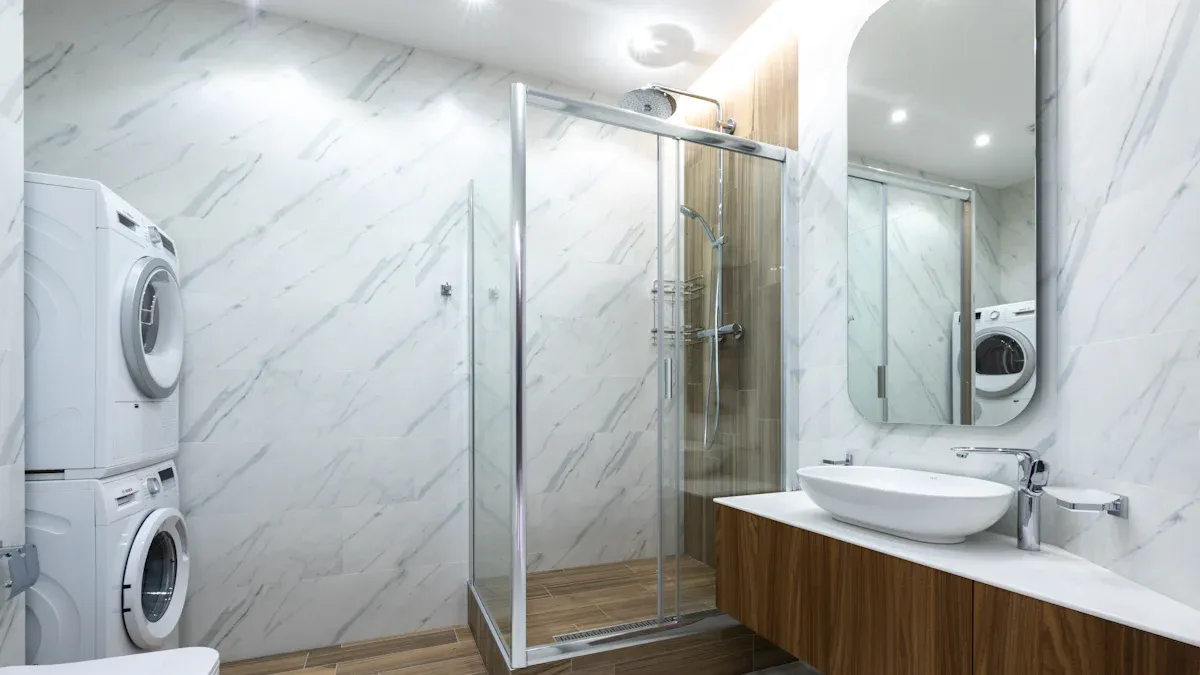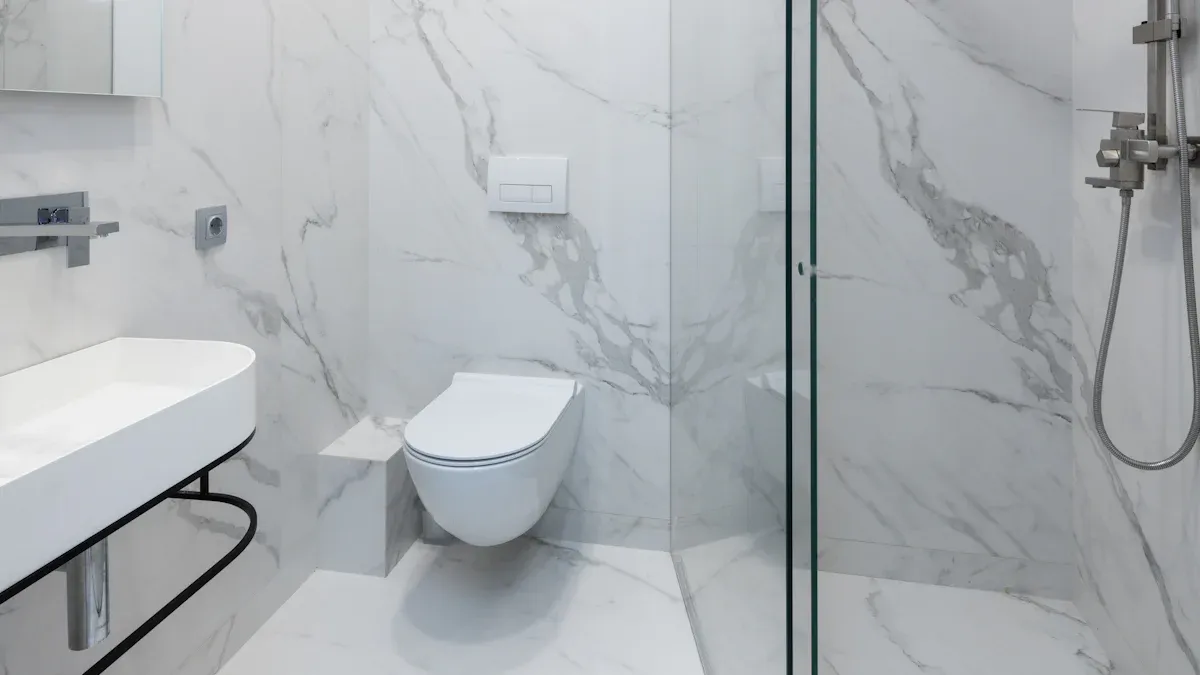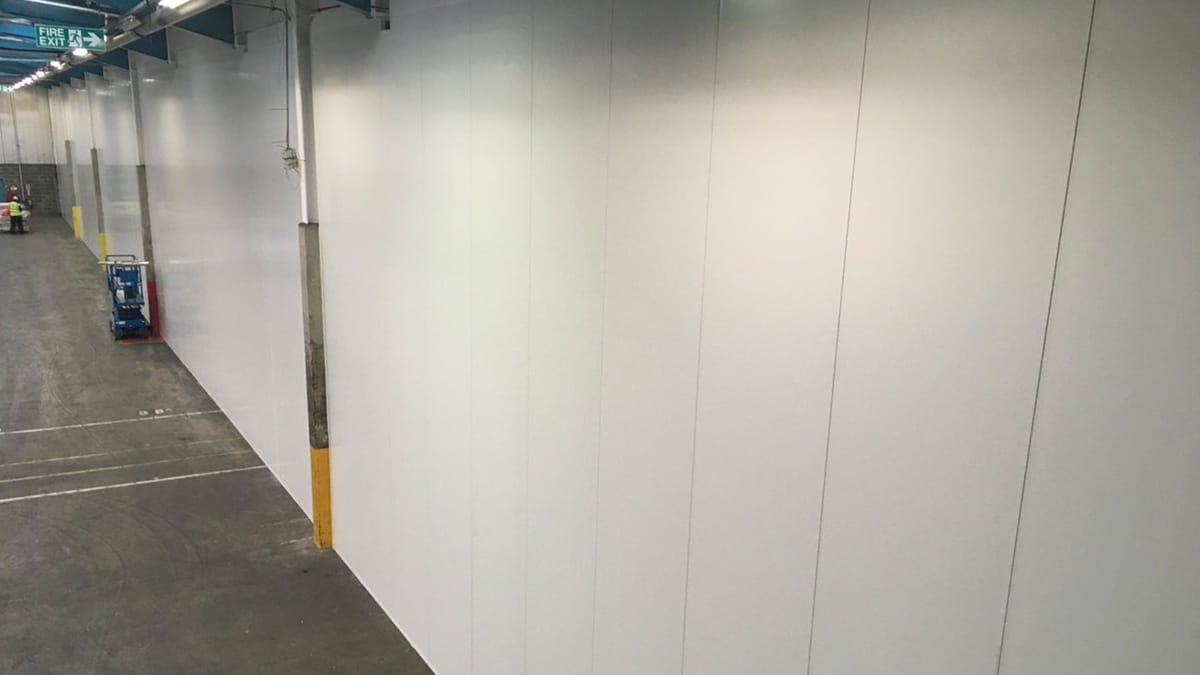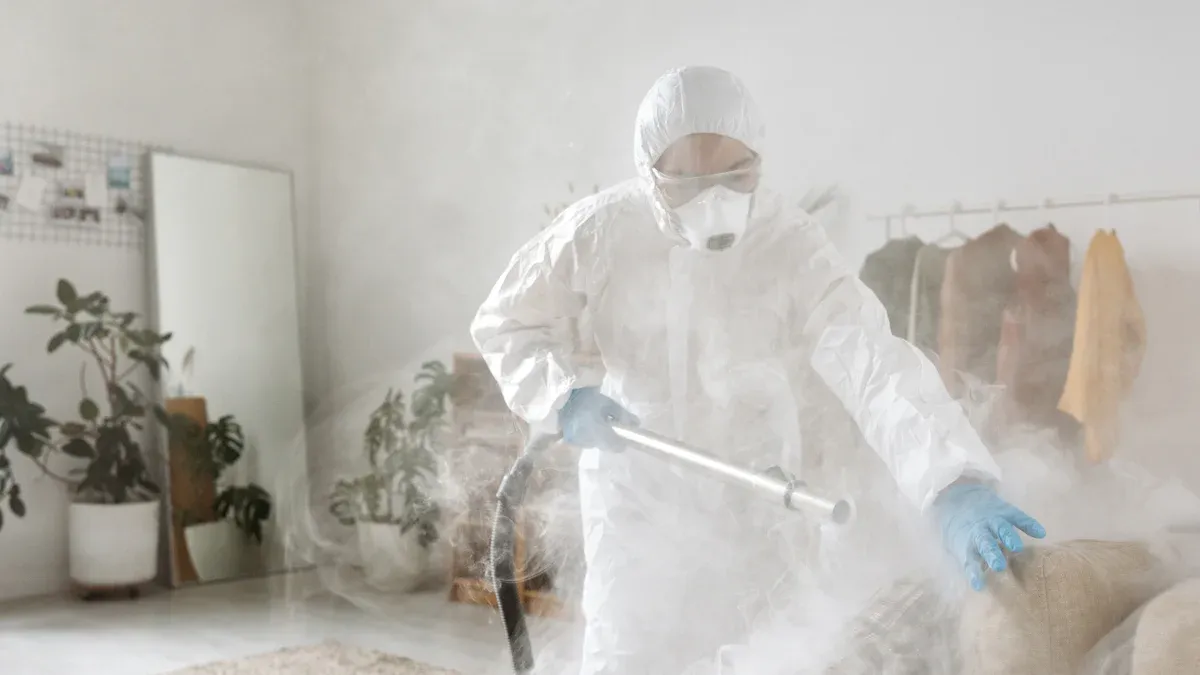
09 Oct Best Mold Resistant Wall Panel Options for Your Home
Table of Contents
You have lots of choices for mold resistant wall panels for your house. Some popular panels are Trusscore pvc wall panels, WPC, Novelio® Mold-X, Glue-On PVC wainscoting, MGO, FRP, cement board, green board, and fiberglass faced panels. These panels use water-resistant materials. They keep water out and stop mold from growing.
Feature | PVC Wall Panels |
|---|---|
The surface does not let water build up | |
Mold Resistance | Stops mold and mildew from forming |
Installation | Simple to put in |
Anti-bacterial Coating | Stops bacteria and germs from growing |
Key Takeaways
Mold resistant wall panels help stop mold and mildew. They keep the air in your home clean and safe. – Pick the best panels for each room. Use PVC panels in bathrooms. Use cement boards in kitchens. Use MGO panels in basements. – Take care of your panels often. Clean them with vinegar. Use dehumidifiers to keep them dry. This helps stop mold and makes the panels last longer.
Mold Resistant Panels

Why Mold Resistance Matters
You want your home to stay clean and safe. Mold grows fast in damp, warm places, especially when wood or drywall gets wet from leaks or condensation. Regular walls can soak up water, making it easy for mold and mildew to spread. Mold resistant panels help you avoid these problems. These panels do not absorb water, so they resist mold and mildew even in tough spots like bathrooms and basements.
Mold thrives when there is moisture, so keeping your walls dry is key.
Moisture-resistant panels, such as pvc wall panels, block water from getting inside your walls.
Mold resistant panels protect your home from mold damage and keep it looking fresh.
You can avoid expensive repairs caused by water problems.
Tip: Use strong panels with high resistance to water in areas that get wet often. This simple step can help you resist mold and mildew for years.
Health and Home Benefits
Mold in your home can cause many health problems. You might notice allergies, coughing, or even asthma getting worse. Some molds release toxins that can lead to rashes, fatigue, or more serious issues. Mold resistant panels help keep your indoor air clean by stopping harmful spores from spreading.
You reduce the risk of allergic reactions, eye irritation, and breathing problems.
You protect your family from toxic effects, such as skin rashes or lung inflammation.
Mold resistant panels extend the life of your home by stopping water and mold damage.
These panels, especially pvc wall panels, are easy to clean. You only need a damp cloth and mild soap.
You spend less time and money on repairs because these panels are strong and need little care.
Choosing the right panels gives you peace of mind and a healthier home.
Types of Moisture-Resistant Panels
PVC Panels
PVC wall panels are a great choice for wet areas. Trusscore PVC panels use virgin vinyl and have a smooth surface. This keeps water out and stops mold and mildew.
Some important things about Trusscore PVC panels are:
They have low-VOC emissions, which help the air inside.
Their material does not let mold or mildew grow.
The surface is non-porous, so it blocks bacteria and viruses.
They do not swell or grow mold, even if they get wet many times.
Here is a table to show how PVC wall panels compare to others:
Panel Type | Additional Notes | |
|---|---|---|
PVC Panels | High | Seamless, non-porous, easy to clean, blocks mold growth. |
FRP Panels | Moderate | May support some mold growth if not installed properly. |
Plastic Panels | Low | Less resistant to moisture and mold. |
You can put PVC wall panels in bathrooms, basements, laundry rooms, and kitchens. They are simple to install and clean, so they are good for busy homes.
Note: PVC wall panels are very good at stopping mold. They work well in places that get wet a lot.
MGO Panels
 MGO panels, or magnesium oxide boards, are made from minerals. Mold, mildew, and pests cannot live on them. These panels do not rot or attract termites. MGO panels are good for humid places and for basement walls, bathroom ceilings, or container homes.
MGO panels, or magnesium oxide boards, are made from minerals. Mold, mildew, and pests cannot live on them. These panels do not rot or attract termites. MGO panels are good for humid places and for basement walls, bathroom ceilings, or container homes.
Main things about MGO panels:
They are very strong and resist water.
Mold and mildew cannot grow because of their makeup.
They do not swell, rot, or break down when wet.
But, it can be hard to get a smooth finish with MGO panels. You might need extra steps, which can cost more time and money. MGO panels can also break easily, so be careful when you put them in.
Tip: Pick MGO panels if you want strong, long-lasting protection from water and mold.
FRP Panels
FRP panels, or fiberglass reinforced plastic panels, are good for wet spaces. Mold, mildew, termites, and rot cannot grow on them. You often see these panels in cleanrooms, commercial kitchens, and bathrooms. They help keep places clean and free from mold.
Good things about FRP panels:
They do not soak up water.
They help keep mold and mildew away.
FRP panels are easy to wipe and keep clean.
FRP panels resist mold, but you must install them right. If there are gaps or bad seals, water can get behind and cause mold.
Fiberglass Panels
Fiberglass panels have a moisture-resistant gypsum core and fiberglass mats. This design gives strong protection from mold and mildew. Many fiberglass panels get a 10 for mold resistance on the ASTM D3273 test. This makes them good for wet places.
Property | Description |
|---|---|
Moisture Resistance | Moisture-resistant gypsum core and fiberglass mats protect against mold and mildew. |
Mold Resistance Rating | Scored a 10 for mold resistance (ASTM D3273). |
Durability | Resists warping, rippling, and buckling better than regular gypsum boards. |
Versatility | Can be attached to wood or metal framing or existing surfaces. |
Some fiberglass panels use Microban antimicrobial technology to stop bacteria, mold, and mildew. You can use these panels in commercial, medical, or farm buildings, and in homes. They do not cost much, between $1.40 and $3.00 per square foot.
Note: Fiberglass panels are smart for places with little airflow, like campers, trailers, or basements.
Cement Board Panels
Cement board panels are strong and resist water. They have a thin layer of concrete between fiberglass layers. This gives them the lowest water absorption rating (ASTM C473) and the best score on mold tests (ASTM D3273 and ASTM G21).
Property | Rating |
|---|---|
Water Absorption | Industry’s lowest (ASTM C473) |
Mold Growth Resistance | Highest possible (ASTM D3273, G21) |
Cement boards do not break down when wet, so they are great for showers. You should put a vapor barrier behind the cement board to protect the frame. Attach the cement board to studs or a subfloor for best results. Using cement board can help you save money on waterproofing.
Tip: Cement board panels are best for bathrooms, laundry rooms, and kitchens where water is common.
Green Board Panels
Green board panels look like drywall but have thicker paper with wax. This makes them better at resisting water than normal drywall. You can use green board in bathrooms and basements.
But, green board does not stop mold as well as new products. It is not fully waterproof and should not go in showers or saunas. If green board stays wet too long, it can break down or have problems.
Green board is good for places with some moisture.
New drywall products, like Sheetrock® Brand Humitek® Gypsum Panels, protect better against water and mold.
Note: Use green board for walls in humid rooms, but not in places with lots of water all the time.
How Panels Resist Mold and Mildew

Key Features
When you choose mold resistant panels for your home, you get strong protection against mold and mildew. The best panels use non-porous materials like pvc wall panels. These panels repel water instead of soaking it up. You do not see grout lines, so there are fewer places for moisture to collect. The seamless design looks clean and helps stop mold from growing. Moisture-resistant panels also block bacteria and keep your walls safe.
Non-porous pvc wall panels push water away.
No grout lines means less chance for mold and mildew.
Seamless panels give your room a smooth look and better resistance.
Strong materials help your panels last longer in wet areas.
Tip: Pick panels with a smooth, non-porous surface for the best mold resistance.
Maintenance Tips
You keep your panels working well by following simple steps. Use mold-resistant or water-resistant coatings to add extra protection. Place panels in rooms that do not get too much water. If you see mold, mix equal parts water and vinegar, scrub the spot, rinse, and dry it. You can use a dehumidifier in damp climates to control moisture. In dry places, a humidifier helps keep humidity between 40% and 60%. Avoid putting panels near heating vents or direct sunlight to prevent fading and warping.
Coat panels with mold-resistant or water-resistant products.
Clean mold with water and vinegar, then dry the area.
Use dehumidifiers or humidifiers to manage moisture.
Keep panels away from heat sources and sunlight.
Note: Regular cleaning and smart placement help your panels stay strong and mold resistant for years.
Panel Comparison
Quick Reference Table
It is important to pick the right panels for your house. The table below shows how mold resistant panels compare. You can check their mold resistance, strength, how easy they are to put in, and their price.
Panel Type | Mold Resistance | Durability | Installation | Cost ($/sq.ft) |
|---|---|---|---|---|
PVC Wall Panels | Excellent | Strong | Easy, lightweight | 1.80 – 3.20 |
WPC Panels | Very Good | Strong | Simple, robust | 2.50 – 4.00 |
FRP Panels | Good | Tough | Moderate | 2.00 – 3.50 |
Cement Board | Excellent | Very Strong | Moderate, heavy | 2.00 – 3.00 |
Green Board | Fair | Moderate | Easy, drywall tools | 1.50 – 2.50 |
Fiberglass | Excellent | Strong | Easy, versatile | 1.40 – 3.00 |
Tip: PVC wall panels and cement board panels give great mold resistance. They are best for rooms that get wet.
You can pick different panels for each room in your house:
Bathrooms: Use PVC wall panels, cement board, or fiberglass panels.
Kitchens: Try WPC panels, PVC wall panels, or FRP panels.
Basements: Choose SPC panels, fiberglass panels, or cement board.
Moisture-resistant panels keep water out. They help stop mold from growing. These panels are strong and easy to clean. Water-resistant panels last a long time and save you money. Most panels can be installed with simple tools. Cement board is heavy and needs extra support.
Water-resistant panels are best for bathrooms, kitchens, and basements. They make rooms look neat and help you worry less about mold. Mold resistant panels help keep your home safe and clean.
Choosing Panels for Your Home
Factors to Consider
You should pick the right panels for each room. Think about how you use every space. Bathrooms and kitchens need panels that keep out water. These rooms get wet a lot, so mold can grow. Basements often feel damp, so use moisture-resistant panels there. Look at what the panels are made of. Cement board and MGO panels last a long time and are very strong. Check if your area is humid or dry. If you live where it is humid, use moisture-resistant cladding for extra safety. You can help the planet by choosing panels made from recycled or eco-friendly stuff.
Here is a table to help you compare important factors:
Factor | Description |
|---|---|
Room Type and Use | Pick panels for bathrooms, kitchens, and basements where water and mold are common. |
Moisture Resistance | Choose panels that block water, especially in damp rooms. |
Select durable panels like cement board or MGO for high moisture areas. | |
Environmental Conditions | Think about your climate and humidity when choosing panels. |
Sustainability | Use eco-friendly panels that are safe and recyclable. |
Tip: You save time and money when you pick panels that fit your room.
Room Recommendations
Different rooms need different panels. Bathrooms and kitchens do best with pvc wall panels. These panels are waterproof and easy to clean. Cement boards are also good for showers and wet places. MGO panels stop mold and last a long time in damp rooms. WPC panels look like wood and work well in kitchens and balconies. SPC panels are great for fancy bathrooms and spa areas because they resist water and fire.
Here are some top choices for each room:
Bathrooms: pvc wall panels, cement boards, SPC panels
Kitchens: pvc wall panels, WPC panels
Basements: moisture-resistant panels like MGO panels or cement boards
When you use the right panels, you get strong protection. These panels keep water out and help your home stay safe. Most panels are simple to put in and clean. You can have a strong and healthy home for many years.
You have lots of choices for mold resistant panels at home. The table below lists the main benefits of each type. Some panels are very good at stopping water and are easy to clean. When you pick panels, think about water, how to install them, and the price. If you choose pvc wall panels, do these things next:
Wall Panel Type | Key Benefits |
|---|---|
MgO Board | Very tough, blocks water, helps air stay clean, great for wet rooms, needs fewer fixes. |
Green Board | Works well in damp spots, keeps out water, good for laundry rooms and small bathrooms. |
Purple Board | Best for humid places, stops mold and water, does not burn easily, strong and lasts long. |
Cement Board | Super strong, goes under tiles, blocks water and mold, perfect for wet areas, has no stuff that mold likes. |
Take out old panels that are damaged and fix any water leaks.
Make sure your work area is clean and get your tools ready.
Ask experts for help if you find mold or worry about the building’s safety.
FAQ
What is the best panel for a bathroom with lots of moisture?
PVC wall panels work best in bathrooms. You get waterproof protection and easy cleaning. Mold cannot grow on the smooth, non-porous surface.
Can you install mold resistant panels by yourself?
You can install most panels with basic tools. Follow the instructions from the manufacturer. Ask for help if you need to cut heavy panels.
How do you clean mold resistant wall panels?
Use a damp cloth and mild soap. Wipe the surface gently. Avoid harsh chemicals. You keep panels looking new and stop mold from coming back.
